Microdosing Psilocybin: Hope, Hype or Healing?
- Jayme Weismann
- Apr 6
- 3 min read

Microdosing psilocybin continues to capture public curiosity as both anecdotal accounts and scientific inquiry try to untangle its true potential. While much of what we know is based on user reports and early research, a growing number of studies are beginning to examine the effects more closely—and the results, while promising, also raise important questions.
What the Research Is Beginning to Show
In a recent observational study, 98 individuals were asked to reflect daily over six weeks on their levels of:
• Happiness
• Focus
• Creativity
• Productivity
• Mindfulness
Participants reported higher scores across all five categories on the days they microdosed psilocybin. These findings echo a wave of anecdotal reports claiming that microdosing enhances daily function, uplifts mood, and promotes creative flow.
But here’s where it gets interesting—and complicated.
Placebo Effect or True Neurobiological Change?
One of the big challenges in this field is determining whether the reported benefits stem from the chemical effects of psilocybin—or from the expectations people bring to the experience. This is often referred to as the placebo effect, and it’s especially tricky when it comes to psychedelics, where mindset and intention play such a large role.
That said, even if expectations are contributing to the outcome, the results are still valuable. Feeling better, thinking more clearly, and functioning more effectively—regardless of the mechanism—can make a real difference in someone’s quality of life.
Promising Avenues of Exploration
Despite the challenges, the encouraging reports—combined with strong evidence from full-dose psychedelic studies—have driven researchers to explore the real neurological potential of microdosing. Some scientists believe that low doses of psilocybin may help:
• Form new neural connections
• Enhance neuroplasticity
• Reduce symptoms of anxiety, depression, and even ADHD
These are bold claims—and while they’re not yet conclusive, they’re backed by the growing curiosity within neuroscience and mental health fields.
The Research Puzzle: Too Many Variables
As with any emerging science, there are hurdles. One of the biggest is the difficulty in isolating variables in microdosing studies. For example:
• Was the participant already in good mental health?
• Did age or gender influence their response?
• Were they taking other medications or undergoing therapy?
• Was there a control group for comparison?
Many studies so far are observational, meaning they rely on self-reported data without control groups. While this information is valuable, it doesn’t allow researchers to confirm that the microdosing itself caused the improvements.
In one such study, participants reported reduced symptoms of depression and stress, along with lower levels of distractibility—but no control group was included, making it hard to rule out other contributing factors.
What About Dosing and Frequency?
Microdosing is not a one-size-fits-all practice. A study analyzing forum posts from nearly 200,000 members found that:
• Most individuals took between 5% and 20% of a typical recreational dose
• Many followed a pattern of dosing every few days, often with a day or two off in between
• Psilocybin and LSD were the most frequently mentioned substances for microdosing
This lack of consistency makes it even more difficult to standardize research protocols—but also reflects the organic, personalized way many people are engaging with this practice.
Final Thoughts: Between Curiosity and Caution
Microdosing psilocybin is generating a wave of excitement for its potential to enhance creativity, mood, and mental clarity. But as with any new approach to wellness or mental health, it’s important to hold both hope and discernment.
Scientific exploration is still catching up to the stories being shared online and in community spaces. The early evidence is compelling, but we need more rigorous, controlled research to truly understand the benefits, risks, and best practices for this emerging field.
In the meantime, what we do know is that thousands of people are experiencing real shifts—and that in itself is worth paying attention to.







Comments